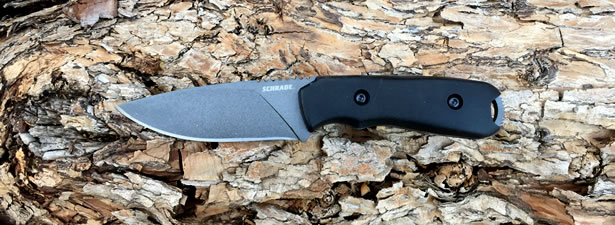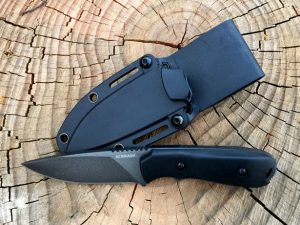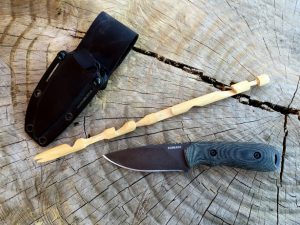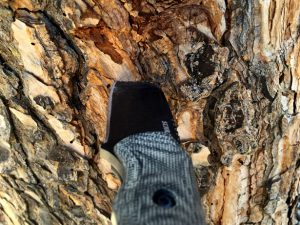Schrade SCHF55 Frontier Fixed Blade Knife Reviewed

Marketing from Schrade
Schrade Mini Frontier Full Tang Fixed Blade Knife, 1095 High Carbon Steel Blade, Grivory Handle, Multi-Carry Option Black Glass Filled Nylon Belt Sheath with Rubber Belt Loop, Grommet Holes and Slots.
Manufacturer: Schrade, www.schrade.com
Model: SCHF55
Overall Length: 7.63″ (19.38 cm)
Blade Steel: 1095 High Carbon Steel full-tang blade
Blade Length: 3.55″ (9.02 cm)
Blade Thickness: 3/16″ (4.81 mm)
Handle Material: Grivory Handle Scales
Handle Length: 4.12″ (10.46 cm)
Weight: 5.92 oz
Accessories: Black Polyester Belt Sheath, Ferro Rod
Warranty: Limited Lifetime Warranty against any manufacturing defects
Origin: Made in China
UPC: 044356226424
MSRP: $61.32
The Review
I’ve been a fan of Schrade and Brian Griffin-designed blades ever since the SCHF9 that I reviewed a couple years ago. Then again with the SCHF42 that I reviewed just last year. This time around, I’ll be putting Schrade’s latest Griffen-designed blade, the SCHF55 to the test…

Initial Thoughts
One of the newest additions to Schrade’s Frontier Series is the all new SCHF55 fixed blade knife that was first announced back in November of last year when Schrade gave out some early prototypes and a pre-production run to various YouTubers. But it wasn’t formally released to the public until a few short months ago.
After what seemed like forever, a shiny new SCHF55 finally arrived at my doorstep. It has many design characteristics in common with the beloved SCHF42, including its powder-coated full-tang 1095 high carbon steel blade and lightly textured black grivory handle slabs. Even the jimping on the spine and the hammer pommel share many similarities. However, the blade pattern actually resembles the SCHF42D which does not have a recurve like the SCHF42.
 With a blade length of only 3.55″, I would not expect to do much chopping or batoning with the SCHF55. I would certainly consider it to be more of a bushcraft or companion blade than a survival knife that seconds as a chopper. For some like myself who think that it is a very capable design in spite of its small size, that is enough.
With a blade length of only 3.55″, I would not expect to do much chopping or batoning with the SCHF55. I would certainly consider it to be more of a bushcraft or companion blade than a survival knife that seconds as a chopper. For some like myself who think that it is a very capable design in spite of its small size, that is enough.
The SCHF55 has a full-tang made from 1095 high carbon steel blade with a high-flat grind and an attractive PTFE-coated finish, but without the distal taper like its SCHF42 and SCHF42D siblings. The jimping on the spine feels slightly aggressive. I typically like it more like the jimping on Schrade’s SCHF35. Another one of my favorites in this space. The pommel has aggressive knurling on the end as well.
The SCHF55 also has comfortable grivory handle scales that are lightly textured and very comfortable to wield with or without gloves. However, after replacing the grivory scales on my SCHF42 with micarta scales from LMF Knives, there was no way that I would leave these alone. In fact, I already had a new set of beautiful micarta scales ready to go long before the SCHF55 arrived at my door.
Schrade opted for a black glass-filled nylon sheath this time around, which in my opinion is a much better choice than the leather belt sheaths that came with the SCHF42 and SCHF42D. It is easily convertible to accommodate left-handed, cross-draw and horizontal-carry configurations. The sheath also has 6-reinforced grommet holes and two slits on both sides for even more carry options.
Features
So now lets focus on the SCHF55’s features in greater detail…
The Blade
Schrade’s SCHF55 is a small, but stout full-tang fixed blade made from a solid 3/16″ piece of 1095 high carbon steel end to end for its superior strength, rigidity and edge retention. It has an overall length of 7.63″, a blade length of 3.55″ with no serrations, and weighs in at only 5.92 ounces.
1095 high carbon steel is one of the most popular tool steels available for survival blades due to the fact that it is much harder than other steel and stainless steel alloys, and it tends to hold an edge much longer even after a lot of use. Not to mention, it is typically easier to sharpen than comparable steel and stainless alloys which makes it an excellent choice for a survival-style blade.
 The biggest drawback to 1095 high carbon steel is its susceptibility to rust without proper care and maintenance, even with a protective PTFE (PolyTetraFluoroEthylene) coating which is also known as Teflon. However, by keeping the SCHF55 dry and lightly oiled when not in use, it will likely last you a lifetime and then some.
The biggest drawback to 1095 high carbon steel is its susceptibility to rust without proper care and maintenance, even with a protective PTFE (PolyTetraFluoroEthylene) coating which is also known as Teflon. However, by keeping the SCHF55 dry and lightly oiled when not in use, it will likely last you a lifetime and then some.
The SCHF55 features an attractive drop-point blade pattern with a gradual high-flat taper located on both sides of the blade, running nearly the entire the width from the blade’s edge to the 90° spine resulting in a beautiful blade geometry. Full and high-flat grinds are not very common commercially due to the amount of material that must be removed by grinding so it is a design characteristic that is typically only found on higher-end cutlery.
Jimping is a term used when describing the small notches cut into the back of a blade to prevent your fingers from sliding when using the knife. The SCHF55 features six aggressively cut notches along the top edge of the spine just beyond the handle for a variety of gripping options. This factory jimping seems too aggressive for my taste so I will likely tone the sharpness down with a file at some point in the future.
The Handle
The SCHF55 has a comfortably-contoured handle made from a black grivory. It is made from an extremely durable synthetic glass-filled nylon-based thermoplastic resin also known as polyphthalamide. It is often used to replace metals in high temperature electrical applications requiring high mechanical strength and thermal resistance which is why it is an attractive material for cutlery scales.
The two grivory 4.12″ handle slabs are attached through the tang with two recessed allen bolts threaded directly into the knife steel allowing it to absorb much of the shock when chopping or batoning, thereby reducing fatigue. The handle’s ergonomic design is lightly textured and well-contoured with an index finger groove and a moderate palm-swell making it easy to hold on to wet or dry, with or without gloves.
The pommel located at the base of the handle has aggressive knurling to prevent slippage when striking material, and just above the pommel, there is an elongated lanyard hole that provides a wide-variety of tethering options.
The Sheath
When not in use, the SCHF55 is protected by a black glass-filled nylon belt sheath that can be easily converted to accommodate a Wide-variety of carry options including left, right or cross-draw and horizontal-carry. The outer perimeter of the sheath has 6-reinforced grommet holes and two slits for webbed straps for even more carry options.

Functional Testing
Now lets see what the SCHF55 can do… In order to provide a some sort of apples-to-apples comparison between blades, I will be performing four durability tests; Batoning, Fine Blade Control, Tip Strength and Edge Retention. In a real survival situation, all resources are fair game. However, since I am not in a life-or-death situation, I’ll stick to some dead wood that I have lying around for these tests.
Prior to all of the functional testing, the SCHF55 was not all that sharp. In fact, it was barely able to slice through a sheet of paper without tearing it. As a result, I had no choice but to tuneup the edge at least to the point were I thought it should be straight from the factory. After tuning up the blade to the point of being able to slice through a sheet of paper without tearing it, I finally began the functional testing.
Batoning
While the SCHF55 has a rugged blade that is 3/16″ thick, certainly tough enough to power through most logs, the blade is barely over 3.5″ long so you probably wouldn’t be processing a lot of heavy material with it.
 For the first part of this test, I tried to crosscut a few sticks 2″ diameter down to a length of 16″ with an 18″ baton. I would later be using these pieces to split into kindling. As I drove the blade through the material, it provided very little resistance for the high-flat grind and teflon coating of the SCHF55.
For the first part of this test, I tried to crosscut a few sticks 2″ diameter down to a length of 16″ with an 18″ baton. I would later be using these pieces to split into kindling. As I drove the blade through the material, it provided very little resistance for the high-flat grind and teflon coating of the SCHF55.
Once I had three pieces cut down to size, I moved on to splitting them into small kindling. To do this, I struck the top of the spine on both ends of the blade, working my way through each of the logs. First halves, then quarters, and so on until I had a small pile of small kindling. By this time I had my new micarta scales SCHF55 which were easily rugged enough to handle being hit with the end of a baton as I split the logs. As a result, the blade went through even the toughest of knots with ease.
Fine Blade Control
The SCHF55 is only the second knife that I’ve reviewed since I decided to standardize my fine blade control testing earlier this year. This drastic change is an attempt to help demonstrate the fine bushcraft capabilities of a blade with much more accuracy and consistency than I had been doing in past reviews.
The method that I’ve adopted is to create a Try Stick like those originally created by Mors Kochanski. There are many different variations of “Try Sticks”, but I have been trying to stick as close to the Mors Kochanski variation as possible which consists of ten common bushcraft notches; Blunt End, Reduction, Pot Hook Notch, Saddle Notch, Dovetail Notch, Latch Notch, 90° Planes, Bow Notch, V Notch and a Root Stripper.
 The first part of this test consists of taking a straight piece of red oak approximately 16″ in length and rounding it, but not less than 3/8″ in diameter. Once the shaft was ready, I began working my way from one end to the other until I had carve all ten notches. The SCHF55 performed fairly well throughout the test, though due to its thickness, it did take some extra effort, patience and ingenuity to cut in some of the notches.
The first part of this test consists of taking a straight piece of red oak approximately 16″ in length and rounding it, but not less than 3/8″ in diameter. Once the shaft was ready, I began working my way from one end to the other until I had carve all ten notches. The SCHF55 performed fairly well throughout the test, though due to its thickness, it did take some extra effort, patience and ingenuity to cut in some of the notches.
To complete the Fine Blade Control testing, I decided to try my hand at feathering a stick because that is likely the most common bushcraft task for testing fine blade control and edge retention. Using one of the pieces of kindling that I had split earlier I started taking long strokes down each of the corners, rounding the stick as I worked my way around it. I was careful not to dig in too much which was relatively easy due to the high-flat grind and teflon coating. As a result, I was able to achieve some pretty fine curls and had a decent-sized pile of tinder ready to light.
Tip Strength
Testing the its ability to stab or pierce without bending or breaking the tip, I drove the blade into the end of a 12″ stump with a baton a little over an 1.5″ deep. Then I loosened the blade using a side-to-side motion until it became loose enough to pull out. I repeated this action a few more times without any sign of bending, breaking, or chipping.
 The final part of the testing the strength of the tip was to bore a hole into the side of a log approximately 12″ in diameter by twisting the blade back and forth. Within a few short minutes of working the blade, I was able to bore a hole approximately 1″ deep and 1″ in diameter.
The final part of the testing the strength of the tip was to bore a hole into the side of a log approximately 12″ in diameter by twisting the blade back and forth. Within a few short minutes of working the blade, I was able to bore a hole approximately 1″ deep and 1″ in diameter.
Edge Retention
The final test for the SCHF55 was to slice through a single sheet of copy paper to demonstrate its ability to hold an edge during the entire testing process, and the SCHF55 did a fine job at that. After all of the other testing had been completed, there were no visible sign of cracks or chips of any kind and the SCHF55 was able to cleanly slice through the paper at least as well as it did after the initial tuneup.
Final Thoughts
Schrade’s new SCHF55 designed by Brian Griffin is a compact and capable fixed-blade knife made from rugged materials that will likely last a lifetime with a little preventative maintenance from time to time. It features an attractive blade geometry and an ergonomic handle profile designed to minimize fatigue. Whether you are processing material into tinder, feathering sticks or whittling trap triggers, the SCHF55 will get the job done and do it comfortably like those twice its price.
If you happen to be a fan of grivory scales, then I think you’ll love them, and if micarta is more you’re style, LMF Knives can make you a pair of beautiful custom scales that will take the SCHF55 to the next level.
If you need a fixed-blade knife somewhere between a small skinner and a big chopper, this blade might be for you. I will certainly be enjoying this one for many years to come. Two thumbs up!
You can find this and other Schrade products here: http://amzn.to/2c0kjZF
![]()
About Taylor Brands and Schrade Cutlery
 Founded by Stewart Taylor in 1975, Taylor Brands has been manufacturing, designing, and distributing high-quality stainless steel cutting tools and accessories since our inception. Taylor Brands owns and produces Schrade, Old Timer, Uncle Henry, and Imperial branded products, and are also licensed to produce multiple product lines under the world famous Smith & Wesson brand. In total Taylor Brands manufactures several hundred different products including fixed and folding knives, collapsible batons, tactical pens, handcuffs, tactical and survival accessories, and flashlights.
Founded by Stewart Taylor in 1975, Taylor Brands has been manufacturing, designing, and distributing high-quality stainless steel cutting tools and accessories since our inception. Taylor Brands owns and produces Schrade, Old Timer, Uncle Henry, and Imperial branded products, and are also licensed to produce multiple product lines under the world famous Smith & Wesson brand. In total Taylor Brands manufactures several hundred different products including fixed and folding knives, collapsible batons, tactical pens, handcuffs, tactical and survival accessories, and flashlights.
--